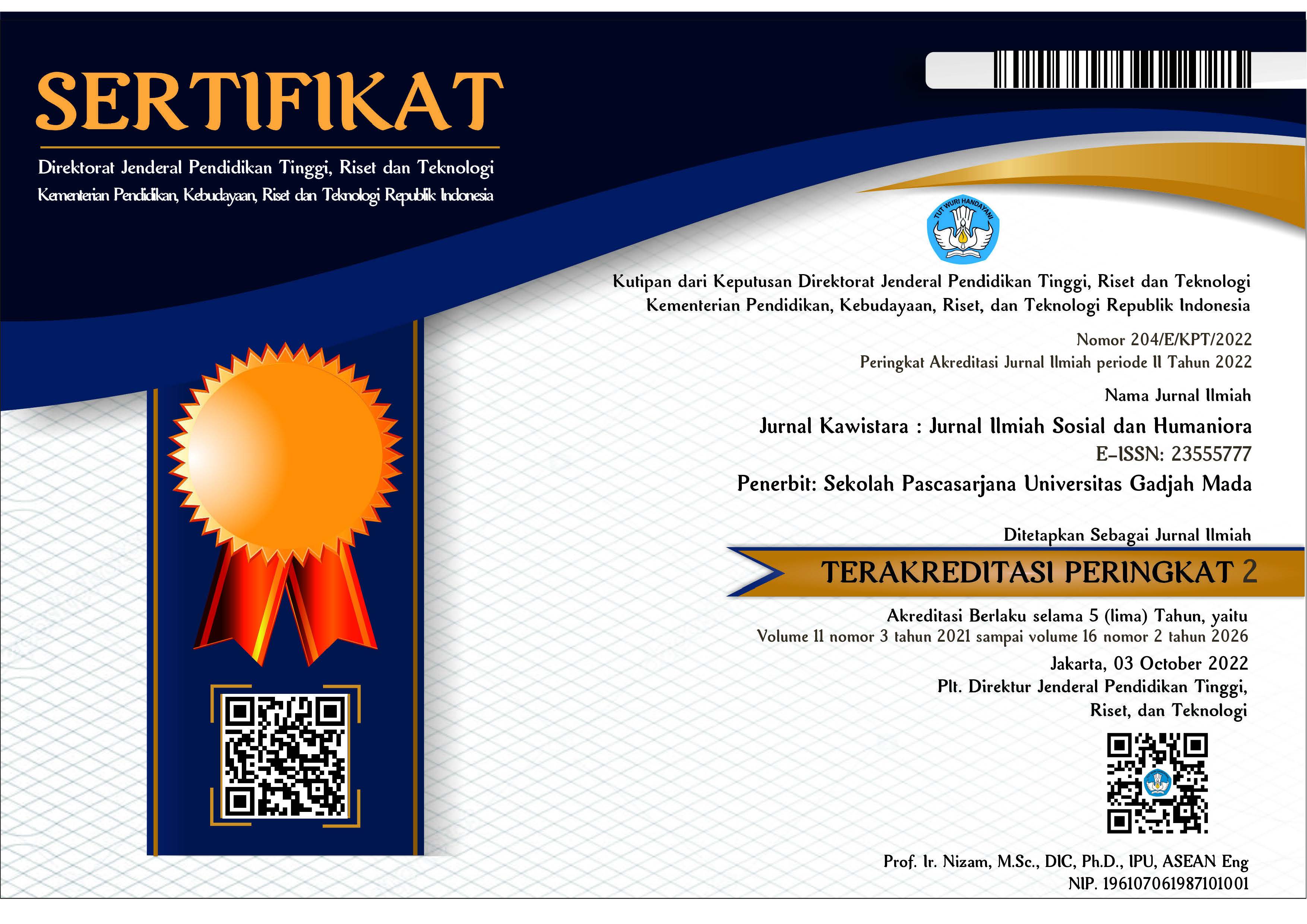Toward Digital Election in Indonesia: Cost Effectiveness Analysis of IVORI (Internet-Voting Republik Indonesia) as an e-Voting System
Desi Ayu Purwanti(1*), Teddy Koerniadi(2)
(1) Universitas Gadjah Mada
(2) Hactiv8
(*) Corresponding Author
Abstract
The election in 2019 was held simultaneously, where people directly elected the DPR, DPD, Provincial/ Regency/City DPRD, President and Vice President on April 17, 2019. All the changes in the implementation of elections in Indonesia since 1999, all of them are still carried out using paper. The history of the simultaneous elections in Indonesia in 2019, which were quite expensive, is a consideration for a more sustainable election process. Since the beginning of this century, internet voting has become the most straightforward and prevalent electoral reform adopted by many countries, with the goal of lowering voting expenses by enhancing convenience. This study aims to compare the Cost-Effectiveness Analysis (CEA) of conventional elections using paper ballots with digital-based elections using internet voting (I-voting) and we also developed a prototype of a digital election system called IVORI (I-Voting Republik Indonesia). The results show that elections using the I-voting system are proven to be 71% more cost-effective than conventional systems. IVORI is an internet-based digital election web application that offers two features, namely “VOTING” which will only be active on election day for voters who are eligible to vote and have been previously registered so that they can log in to the application using their ID number and voting station code and the “INFORMASI KANDIDAT” feature which can be accessed by voters during the candidate’s campaign period which contains information about the background and work program plans of each candidate.
Keywords
Full Text:
PDFReferences
Ananda Teresia. (2020, January 22). Kurangi Kertas, KPU Usul E-Rekap dan Salinan Digital di Pemilu.
Arrsa, R. C. (2014). Pemilu Serentak dan Masa Depan Konsolidasi Demokrasi. Jurnal Konstitusi, 11(3), 515–537.
AssociationVoting. (n.d.). AssociationVoting Online Voting Made Simple. Retrieved October 15, 2023, from https://www.associationvoting.com/
Awad, M., & Leiss, E. L. (2011). Internet voting in the USA: analysis and commentary. Transforming Government: People, Process and Policy, 5(1), 45–55.
Bederson, B. B., Lee, B., Sherman, R. M., Herrnson, P. S., & Niemi, R. G. (2003). Electronic voting system usability issues. Proceedings of the SIGCHI Conference on Human Factors in Computing Systems, 145–152.
Centers for Disease Control and Prevention, O. of P. P. and E. (2021, October 20). Cost-Effectiveness Analysis. Centers for Disease Control and Prevention, Office of Policy, Performance, and Evaluation
Ehin, P., Solvak, M., Willemson, J., & Vinkel, P. (2022). Internet voting in Estonia 2005–2019: Evidence from eleven elections. Government Information Quarterly, 39(4), 101718.
Election Runner by Eko Internet Marketing, L. (n.d.). ellectionrunner . Retrieved October 15, 2023, from https://electionrunner.com/
ElectionBuddy, Inc. (n.d.). ElectionBuddy. Retrieved October 15, 2023, from https://electionbuddy.com/
FISIPOL UGM. (2019, June 25). Hasil Kajian Lintas Disiplin atas Meninggal dan Sakitnya Petugas Pemilu 2019.
Funilkul, S., & Chutimaskul, W. (2009). The framework for sustainable eDemocracy development. Transforming Government: People, Process and Policy, 3(1), 16–31.
Global Election Company. (2010). election.com.
Goodman, N., & Stokes, L. C. (2020). Reducing the cost of voting: an evaluation of internet voting’s effect on turnout. British Journal of Political Science, 50(3), 1155–1167.
KPU. (2014). Realisasi Anggaran Tahapan Pemilu 2014 Tahun Anggaran 2014.
KPU. (2020). Laporan Kinerja KPU Tahun 2019.
Krimmer, R., Duenas-Cid, D., & Krivonosova, I. (2021). New methodology for calculating cost-efficiency of different ways of voting: is internet voting cheaper? Public Money & Management, 41(1), 17–26.
Krimmer, R., Duenas-Cid, D., Krivonosova, I., Vinkel, P., & Koitmae, A. (2018). How much does an e-Vote cost? Cost comparison per vote in multichannel elections in Estonia. International Joint Conference on Electronic Voting, 117–131.
Krimmer, R., Triessnig, S., & Volkamer, M. (2007). The development of remote e-voting around the world: A review of roads and directions. International Conference on E-Voting and Identity, 1–15.
Mcknight, D. H., Carter, M., Thatcher, J. B., & Clay, P. F. (2011). Trust in a specific technology: An investigation of its components and measures. ACM Transactions on Management Information Systems (TMIS), 2(2), 1–25.
Montjoy, R. S. (2010). The changing nature… and costs… of election administration. Public Administration Review, 70(6), 867–875.
Musiał-Karg, M., & Kapsa, I. (2021). Postal or electronic voting? The analysis of the preferred voting methods in the context of failed electoral reform in Poland. Transforming Government: People, Process and Policy, 15(3), 347–359.
Omotayo, F. O., & Adekunle, O. A. (2021). Adoption and use of electronic voting system as an option towards credible elections in Nigeria. International Journal of Development Issues, 20(1), 38–61.
Pieters, W., & van Haren, R. (2007). Temptations of turnout and modernisation: E‐voting discourses in the UK and The Netherlands. Journal of Information, Communication and Ethics in Society, 5(4), 276–292.
Pindyck, Robert. S., & Rubinfeld, Daniel. L. (2018). Microeconomics (9th Edition). Pearson.
Rohmah, N. S. (2019). Evaluasi Sistem Penyelenggara Pemilu Serentak 2019 Ditinjau dari Beban Kerja Penyelenggara Pemilu (adhoc). Call for Paper Evaluasi Pemilu Serentak.
Simhalu, S. K., & Takeda, K. (2007). Browser based agile e-voting system. Advances in Computer Science–ASIAN 2007. Computer and Network Security: 12th Asian Computing Science Conference, Doha, Qatar, December 9-11, 2007. Proceedings 12, 62–69.
TrueBallot, Inc. (2003). TrueBallot Washington, DC .
Valsamidis, S., Kontogiannis, S., Theodosiou, T. G., & Petasakis, I. (2018). A Web e-voting system with a data analysis component. Journal of Systems and Information Technology, 20(1), 33–53.
Wadowski, G. M., Otte, L. S., Bernardo, N. D., & Macht, G. A. (2023). A Comparative Study of Electronic Voting and Paper Ballot Systems in Modern Elections. Election Science, Reform, & Administration Conference.
Article Metrics
Refbacks
- There are currently no refbacks.
Copyright (c) 2024 Desi Ayu Purwanti, Teddy Koerniadi

This work is licensed under a Creative Commons Attribution-ShareAlike 4.0 International License.
Jurnal Kawistara is published by the Graduate School, Universitas Gadjah Mada.











